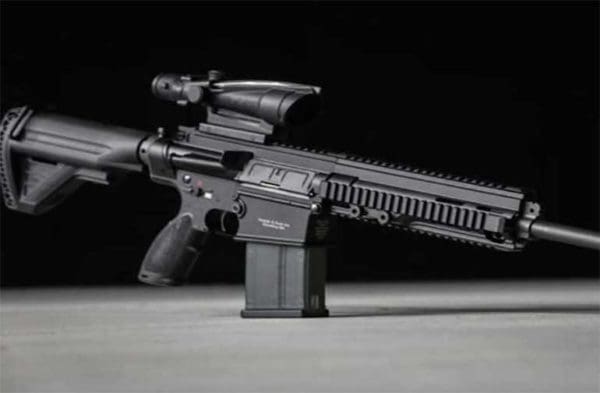John Farnham writes [via ammoland.com]: Last weekend, a student brought an H&K MR762A1 Rifle to my Armed Response to a Terrorist Attack training course last weekend. It’s the commercial version of H&K’s 417, a gas-piston, autoloading, military rifle in 7.62×51 (308) with an “AR profile.” My student fitted his long gun with a 6x ACOG optic (6×48) mounted on the upper receiver.
Like all ACOG optics, the 6×48 is rugged and thoroughly militarized. It’s also bulky, heavy, and pricey ($2,500.00). The reticle is a glowing, orange triangle with assorted other aiming points, designed around the 308 round. Reticle illumination is self-powered, so the optic doesn’t require batteries.
I’m sure the combination of rifle and optic would turn-in a superb performance at 300m-600m, but we were shooting in heavy brush, in the rain, in low light, at targets from twenty to thirty meters. Targets were steel silhouettes, ensconced within fall foliage.
Guess what? My student could not find the targets in his scope!
To be sure, the task was challenging for Aimpoints and EOTechs too, not to mention the best iron sights. But the rest of my students (so equipped) were still able to do it with significant success. The second day, my student removed the 6×48 ACOG from his rifle, and ran with iron sights. He did slightly better. At least he could find targets.
High-magnification optics are convenient for making out downrange detail. As Jeff Cooper put it, they don’t improve your shooting, but they do enable you to see better than would be possible through iron sights or zero-magnification red-dots.
Through high-magnification optics, you get to see “a lot of a little.” For that privilege, you inherit considerable bulk and weight. Plus, all such optics are eye-relief-critical, and thus must be mounted so that they are just a few centimeters in front of your sighting eye.
Bottom line: the rifle and optic combination described above, wonderful though it was, proved itself unsuitable to the close, rapid, 100-meters-and-closer, low-light-in-the-cold-rain shooting that we did.
Red-dots did much better. And, for those with young eyes, iron sights run just fine also, be they Western-style or Soviet-style.
The lesson learned by all present was:
1. You have to run your gear, and yourself, under realistic, even harsh, circumstances, before you can be sure it will serve you adequately.
2. No one piece of gear, no matter the configuration, does everything well. You give-up some capabilities to get others.
3. When you can’t predict the challenge, high-specialized gear is usually contraindicated
